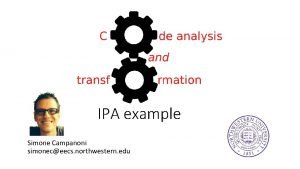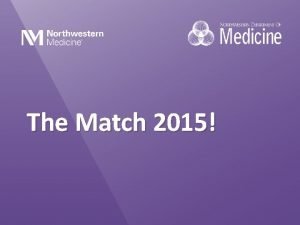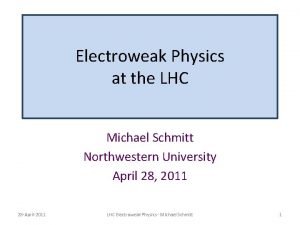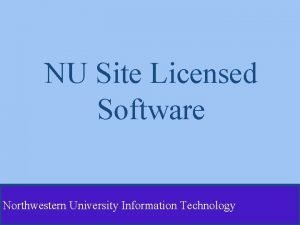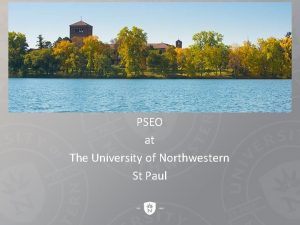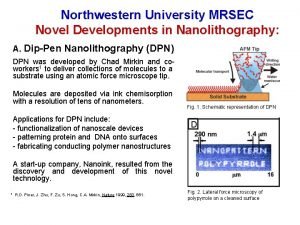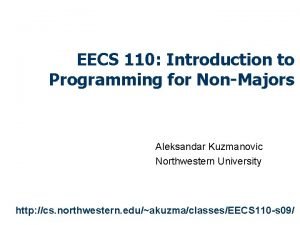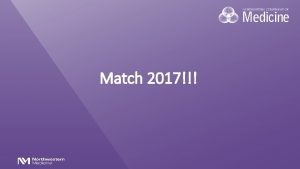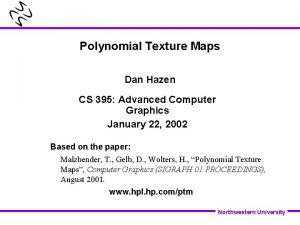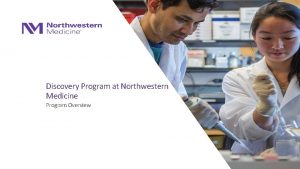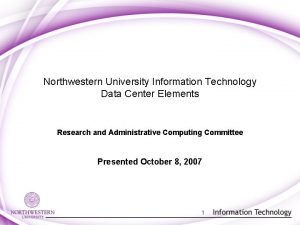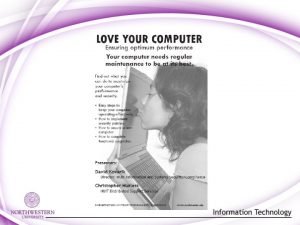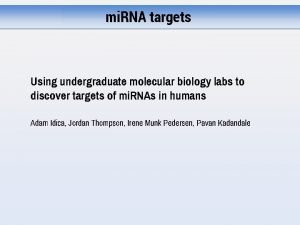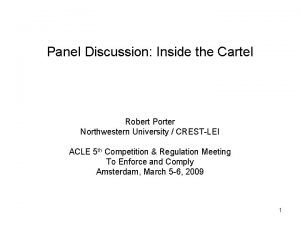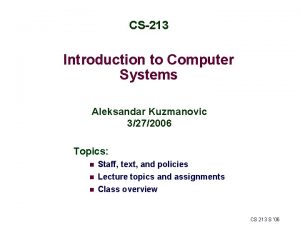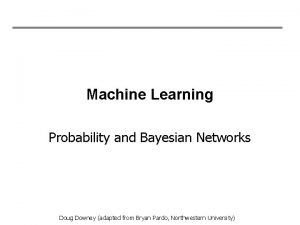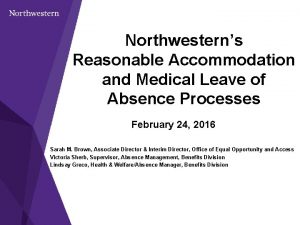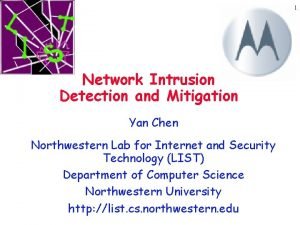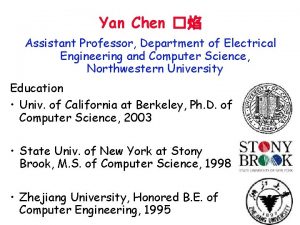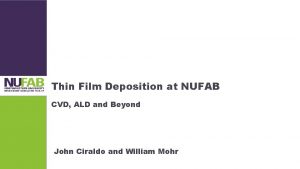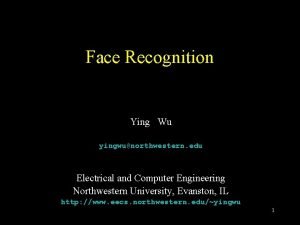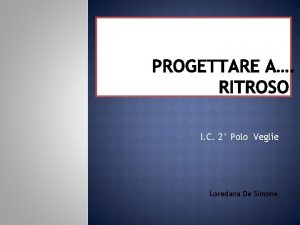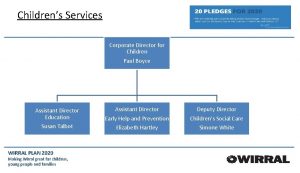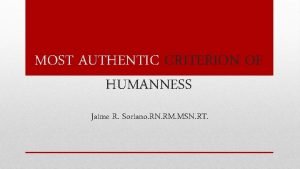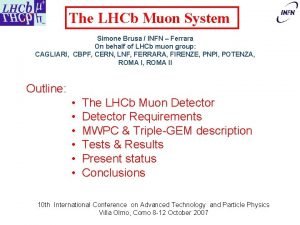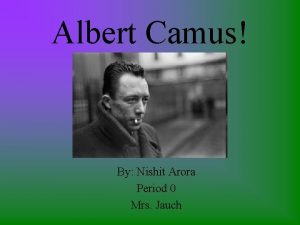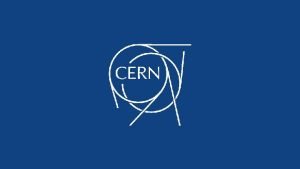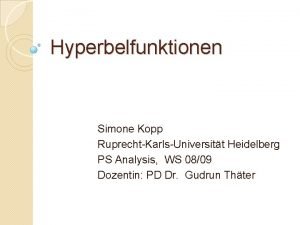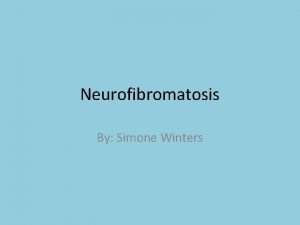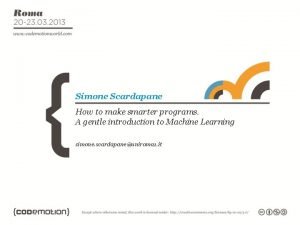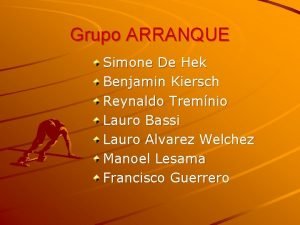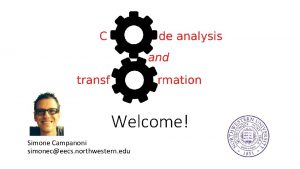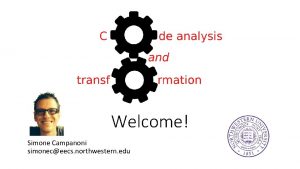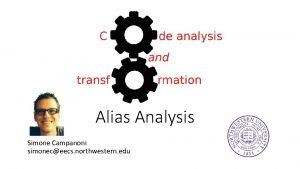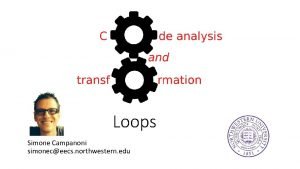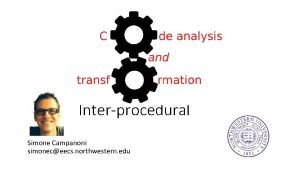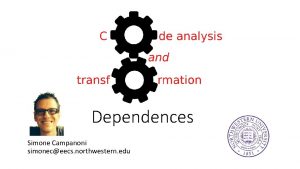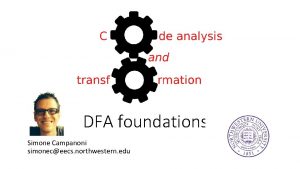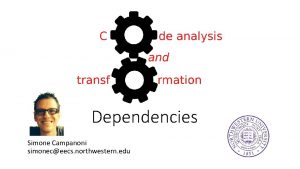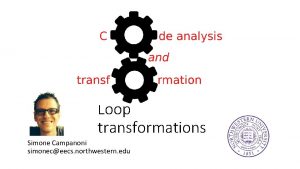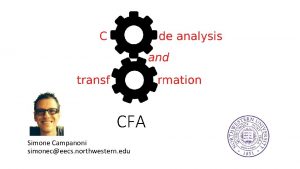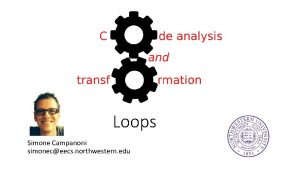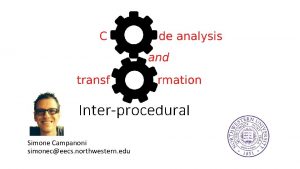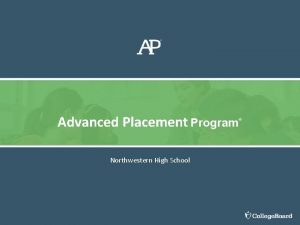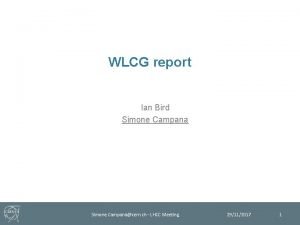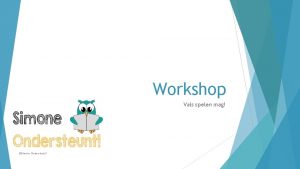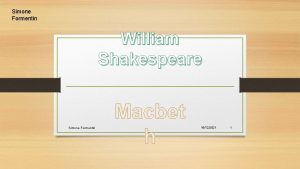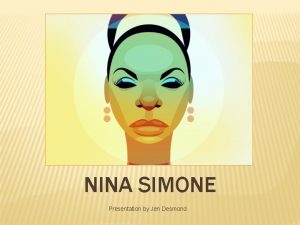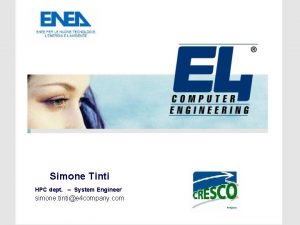Welcome Simone Campanoni simoneceecs northwestern edu Who we

















































- Slides: 49

Welcome! Simone Campanoni simonec@eecs. northwestern. edu


Who we are Simone Campanoni simonec@eecs. northwestern. edu Enrico A. Deiana enricodeiana 2020@u. northwestern. edu

What we are going to do • Teach you code analysis and transformation • What they do • What they could do • What they can’t do CAT

Who you are (or will be) • An engineer • A C++ developer (you don’t have to be an incredible coder) • An enthusiastic learner Compiler expert is not mentioned ; )

Outline of today’s CAT • Structure of the course • CAT and compilers • CAT and computer architecture • CAT and programming language

CAT in a nutshell • • About: understanding and transforming code automatically EECS 396/496 Satisfy the system depth for CS major Tuesday/Thursday 2: 00 pm – 3: 20 pm at LR 2 Tech (here ; )) • Simone’s office hours: Friday 2: 00 pm – 4: 00 pm • But feel free to stop by at my office (2. 217@Ford) any time • Enrico’s office hours: Monday 2: 00 pm – 3: 00 pm, 2. 227@Ford • CAT is on Canvas • Materials/Calendar/Assignments/Grades on Canvas • You’ll upload your assignments on Canvas

CAT materials • Modern compiler implementation • Slides and assigned papers • LLVM documentation http: //llvm. org

The CAT structure Topic & homework Today 12/8 Week Tuesday Thursday Homework

The CAT grading • Homework: 100 points • 10 points per assignment • The first 2 assignments are trivial • Extra points • Extra homework • Answering (correctly) special questions (I will emphasize them) during lectures • Best student so far: 114 points! Grade Points A AB+ B BC+ C D F 95 – 100 90 – 94 80 – 89 70 – 79 61 – 69 57 – 60 50 – 56 25 – 49 0 – 24

Rules for homework • No copying of code is allowed • Tool, infrastructure help is allowed • First try it on your own (google and tool documentation are your friends) • Avoid plagiarism www. northwestern. edu/provost/policies/academic-integrity/how-to-avoid-plagiarism. html • If you don’t know, please ask simonec@eecs. northwestern. edu

Summary • My duties m a x e • Teach you code analysis and transformation • And how to implement them in a production compiler (LLVM) • Your duties l a if n • Learn code analysis and transformation • Implement a few of them in LLVM • • o N Write code Test your code Then, think much harder about how to actually test your code (Sometimes) Answer my questions about your code

Structure & flexibility • CAT is structured w/ topics • Best way to learn is to be excited about a topic • Interested in something? Speak I’ll do my best to include your topic on the fly

Topic & homework Today 12/8 Week 1 Today • Welcome/Structure • Compiler/CAT F. E. M. E. B. E. Thursday LLVM

The role of compilers If there is no coffee, if I still have work to do, I’ll keep working, I’ll go to the coffee shop Code analysis and transformation If there is no coffee{ if I still have work to do{ I’ll keep working; } I’ll go to the coffee shop; } Compilers ? ? ? 0010111001010101011010

Arch Compilers & CATs Practice PL Math

Example of CAT What will it print? var. X = 5 … … print var. X …

Example of CAT What will it print? var. X = 5 … … print 5 … print var. X

Example of CAT var. X = 5 … … print 5 … var. X = 5 … … print var. X … Is it worth transforming? Code Analysis Property Transformatio n Transformed code

Designing CATs • Choose a goal • Performance, energy, identifying bugs, discovering code properties • Design automatic analysis to obtain the required information • Occasionally design the code transformation

Use of CATs • Compilers • Increase performance • Decrease energy consumption • code generation • Developing tools (e. g. , VIM, EMACS) • Understanding code (e. g. , scopes, variables) • Computer architecture

Structure of a compiler Character stream (Source code) i n t ma i n … Lexical analysis Tokens Syntactic & semantic analysis AST INT SPACE STRING SPACE … int main. Function (){ signature printf(“Hello World!n”); Function name Return type return 0; STRING } INT

Structure of a compiler Character stream (Source code) i n t ma i n … Lexical analysis Tokens Syntactic & semantic analysis AST INT SPACE STRING SPACE … Function signature Return type INT Function name STRING

Structure of a compiler Syntactic & semantic analysis AST Function signature Return type INT Function name STRING IR code generation IR ; Function Attrs: nounwind uwtable define int @main() {

Structure of a compiler Character stream (Source code) Front-end IR Middle-end IR i n t ma i n … EECS 322: Compiler Construction ; Function Attrs: nounwind uwtable define int @main() { Code analysis and transformation ; Function Attrs: nounwind uwtable define int @main() { Back-end EECS 322: Compiler Construction Machine code 01010111010101

Structure of a compiler Character stream (Source code) Front-end IR Middle-end Character stream (Source code) Front-end Middle-end Back-end IR Back-end Machine code

Structure of a compiler C Front-end IR Middle-end Java C Front-end Middle-end Back-end IR Back-end Machine code

Structure of a compiler C Front-end IR Middle-end Java Front-end Middle-end Back-end IR Back-end Machine code

Structure of a compiler C Java Front-end FE IR Middle-end Java Front-end Middle-end Back-end IR Back-end Machine code M 2 Machine code

Structure of a compiler C Java Front-end FE IR Middle-end Java Front-end Middle-end Back-end IR Back-end BE Machine code M 2

Structure of a compiler L 1 L 2 Front-end 1 Front-end 2 IR Middle-end IR Back-end A MA Back-end B MB

Multiple IRs • Abstract Syntax Tree R 1 IR needs to be easy 1)to produce 2)to translate into machine code 3)to transform/optimize + R 2 R 3 • Register-based representation (three-address code) R 1 = R 2 add R 3 • Stack-based representation push 5; push 3; add; pop ;

Example of LLVM IR define i 32 @main(i 32 %argc, i 8** %argv) { entry: %add = add i 32 %argc, 1 ret i 32 %add }

Multiple IRs used together L 1 Static compiler IR 1 Dynamic compiler FE IR 2 Dynamic compiler BE Machine code

Multiple IRs used together Java compiler Java bytecode Java VM FE IR 2 Java VM BE Machine code

CATs that we’ll focus on • Semantics-preserving transformations • Correctness guaranteed • Goal: performance • Automatic • Efficient

Evolution of CATs (hardware point of view) • Simple hardware (few resources), simple CATs Core Size Registers Latency Cache L 1 Cache L 2 Memory

Evolution of CATs (hardware point of view) • Simple hardware (few resources), simple CATs Compilers/CATs • Opportunities to improve programs • Challenging CATsare developed in the processor-design stage! • Execution model mismatch between • More hardware resources available to compilers source code and hardware • Challenging CATs

Evolution of CATs (hardware point of view) (2) 1960 - ? : Complex instruction set computing (CISC) 1980 - ? : Reduced instruction set computer (RISC)

Evolution of CATs (hardware point of view) (3) Very long instruction word (VLIW) Superscalar Inst 1 Inst 2 Inst 3 Inst 4 Inst 5 Inst 6 Inst 7 Inst 8 CATs Inst 1 Inst 4 Inst 7 Inst 8 Inst 2 Inst 5 Inst 3 Inst 6

Evolution of CATs (PL point of view) • First electronic computers appeared in the ’ 40 s • They were programmed in machine language 0010111001010101011010 • Low level operations only • Move data from one location to another • Add the contexts of two registers • Compare two values • Programming: slow, tedious, and error prone

Evolution of CATs (PL point of view) • Low level programming language, simple CATs • Not very productive • More abstraction in programming language, more work for CATs to reduce their performance overhead • Macros -> Fortran, Cobol, Lisp -> C, C++, Java, C#, Python, PHP, SQL, … • CATs enable new programming languages

Evolution of CATs (PL point of view) • Abstractions are great for productivity • CATs remove their overhead • But abstractions must be carefully evaluated considering CATs • A simple abstraction in PL can generate challenges for CATs • CATs need to be understood

Evolution of CATs (PL point of view)(2) PL without procedures void main (){ Int v 1, v 2; v 1 = 1; v 2 = 2; … }

Evolution of CATs (PL point of view)(3) Let’s add procedures to our PL • Call-by-Value void proc 1 (int a){…} proc 1(my. Var 1); • Call-by-Reference void proc 1 (int a){…} proc 1(my. Var 1); void proc 1 (int *a){…} proc 1(&my. Var 1);

Evolution of CATs (PL point of view)(2) void my. Proc (int *v 1, int *v 2){ (*v 1) = 1; (*v 2) = 2; } What’s the problem for CATs? … if v 1 and v 2 alias … Understanding if pointers alias: pointer alias analysis This is one of the most challenging problem in CATs

Conclusion • CATs used for multiple goals • Enable PLs • Enable hardware features • CATs are effected by • Their input language • The target hardware • When you design a PL or a new hardware platform, you need to understand what CATs can and can’t do • Some cant’s become can thanks to research on CATs

Ideal CATs • Proved to be correct • Improve performance of many important programs • Minor compilation time • Negligible implementation efforts

As Linus Torvalds says … Talk is cheap. Show me the code. Demo time
 Simone campanoni
Simone campanoni Edu.sharif.edu
Edu.sharif.edu Wise men three clever are we
Wise men three clever are we Nick papandreou northwestern
Nick papandreou northwestern Coniferous trees adaptations
Coniferous trees adaptations Chris andrews northwestern mutual
Chris andrews northwestern mutual Ipa source northwestern
Ipa source northwestern Dr lida zheng
Dr lida zheng Northwestern mutual longevity game
Northwestern mutual longevity game Northwestern redcap
Northwestern redcap Northwestern neurobiology
Northwestern neurobiology Michael schmitt northwestern
Michael schmitt northwestern Chris andrews northwestern mutual
Chris andrews northwestern mutual Northwestern european countries
Northwestern european countries Nuit northwestern
Nuit northwestern Northwestern university mn pseo
Northwestern university mn pseo Asrsp northwestern
Asrsp northwestern Northwestern university
Northwestern university David cella
David cella Eecs 110
Eecs 110 Aakash bavishi
Aakash bavishi Northwestern university
Northwestern university Physical geography of northwestern europe
Physical geography of northwestern europe Northwestern medicine discovery program
Northwestern medicine discovery program Northwestern mailroom
Northwestern mailroom Northwestern antivirus
Northwestern antivirus Northwestern oligo calculator
Northwestern oligo calculator Tableau northwestern
Tableau northwestern Robert porter northwestern
Robert porter northwestern Cs213 northwestern
Cs213 northwestern Nucore northwestern
Nucore northwestern Doug downey
Doug downey Northwestern fasis
Northwestern fasis Yan chen northwestern
Yan chen northwestern Yan chen northwestern
Yan chen northwestern Northwestern computer science department
Northwestern computer science department Pvd cvd ald
Pvd cvd ald Ying wu northwestern
Ying wu northwestern Loredana de simone
Loredana de simone Simone white wirral
Simone white wirral Sister simone roach
Sister simone roach Simone brusa
Simone brusa Simone hie
Simone hie Simone montesano
Simone montesano Andrew chapman simmons
Andrew chapman simmons Einheitshyperbel
Einheitshyperbel Dr dennis winters
Dr dennis winters Simone scardapane
Simone scardapane Simone bolivar
Simone bolivar Reinaldo wambeke
Reinaldo wambeke






